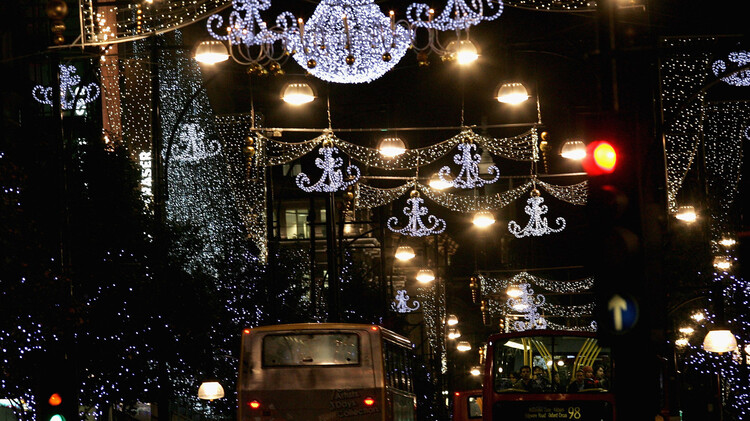That story explains why I dislike led lights
Technology Connections fanbois in 3…2…1…
I love that I get this reference.
I also love that last year he found a company manufacturing strings of white LEDs with colored tips (which is his ideal setup) and said he probably wouldn’t need to make any more annual videos about it anymore.
Cue this year’s video about it lol
✋😐
I grew up with incandescent bulbs, and it was hell. The waste, in both trash and energy consumption, was horrendous.
The (thankfully) short age of flourescent reduced energy use, but the trash was worse, and the light categorically regressive.
LEDs are, in all ways, superior. You buy cheap-ass crap LEDs, you’re going to get a worse experience, obviously. Despite some negatives, LEDs are still the best lighting technology available. Feel free to complain, but there’s no better option right now. Wanting to go back to incandescents is vinyl-turntable-level, selective memory, retro hipsterism. And also super shitty for the environment.
We may be annoying, but we’re right damnit!
But did you read the story? It doesn’t discourage use of LED products. The issue is specific LEDs that are manufactured with sub par components that contribute to flicker. Unfortunately it’s the only thing regulation will solve. Personally I’m waiting for headlights to be regulated for glare, position, and color temperature.
Did I read the story?
Yes I know it doesn’t discourage the use of them.
You can too often see the same thing in LED car headlights and tail lights. The most obnoxious of these flicker noticeably all the time. Not much better are the ones that seem to be on continuously when viewed in the center of your vision, but flicker in your peripheral vision. The later I find really distracting
I can’t recall seeing any legal head or tail lights that have flickering issues. We will hopefully see this issue less and less as people are no longer allowed to buy the illegal retrofit kits from places that sell headlights. We’ve seen a lot less people running the Sylvania super bright off-road lights now that you’re not allowed to buy them from the headlight section of an auto parts store and online stores are not allowed to sell them without off-road use popup warnings.
I really wish that instead of useless trash like drunk driver checkpoints midweek we would start seeing headlight inspection points or other vehicle inspection points to check for safety issues like these; if we’re going to keep having these checkpoints for no reason.
On digital rear view mirrors you can really see the flicker on some headlights and DRL because of the framerate of the camera. Most cars are fine but some aftermarket headlights and GMC/Chevy(IIRC) are very noticable.
Thank, NPR, for mentioning migraines as one of the problems.
Now do an article on flickering, eye-piercing, migraine-inducing LED lights on emergency vehicles and crosswalks.
If there are any lights that are understandably bright, it’s those on emergency vehicles.
The bright-ass LED lights on liften trucks though are entirely infuriating.
It’s not the brightness that’s the problem. It’s the sharpness and the strobe. Back in the old days, when they were spinning lights, they were nice and bright and got the job done just fine without those two aspects.
Hell, even as annoying as the xenon strobes were, they were never anywhere near as disorienting as the LED strobes on the emergency vehicles now. That and the low sound range sirens… They make me nauseous when they pass close by.
They must have watched this video https://youtu.be/va1rzP2xIx4?feature=shared
Lol was wondering if someone would post his video
I came here for Technology Comnections, and found it.
Thanks. I was just reading about the flicker of different LEDs this morning due to my similar distaste for the lack of warmth with current Christmas lights.
Oh, and direct link to article here. https://www.npr.org/2023/12/22/1198908957/led-lights-flicker-headache
The lack of warmth is the color of LEDs, they are based on blues and no reds because of cost and efficiency. In places where you get a lot of sun in the US (Arizona, Southern Cali, etc.), I bet the blues are loved.
Yeah, but you can buy LEDs with different temperatures.
I don’t think you understand the basics of lighting fabrication from that statement and those color temperatures are misleading.
I don’t think you understand the basics of lighting fabrication
probably
Most LEDs are based on a “blue pump”, which means the chip produces a lot of intensity in the blue wavelength range. Color temperatures are produced by adding more phosphor to the chip surface. The phosphor only allows certain wavelengths of color through, and the more phosphor added means the LED will appear warmer in color. More phosphor means more expensive though, which is why lots of LEDs are produced in the 7 to 5k range. Even when adding more phosphor to the chip and having a warmer color temperature, there is still blue light being produced and that can impact your sensitivity. Companies such as BIOS Lighting produce chips that don’t use a blue pump. Long story short, it’s a really complicated field that is long overdue for multiple layers of government regulation.
There are a lot of good articles about it. Explained in a rudimentary way, it’s super hard to make good reds for LED and has been a problem since its inception. OLEDs use little organic red pixels and the blacks turn off all light instead of replicating a black. It’s super interesting. When I was in school, they brought a major LED inventor to show us what they had, it wasn’t good quality light at the time and for a long time afterwards. OLED was the first time I saw good reds. If you go to a costco, look at the difference between the reds on the same pic, can you tell there is a difference or does it all look sort of magenta? That’s how you can tell if it’s a good OLED or not. To be fair though, you can mess with the settings to make it look shitty which some stores do to sell more of a certain type of tv.
I’d be happy to read about it if you can point me in the right direction.
#color #oled #blacks #organic #reds
the blacks turn off all light instead of replicating a black
Wut
No light is emitted? Not sure how to clarify that for you. Instead of making a super dark blue, green, purple, etc., it turns out the light.
My reds on my Christmas lights are not comforting either… Oh, and I live in the South with plenty of sunlight…
That’s interesting to know, I wonder if that’s typical.
Newer LED lights often flicker.
Saved you a click.
That’s not so much the LEDs themselves, as the cheaply designed power supply.
Has anyone here tried https://tru-tone.com/
The ads make them look like the colours of my youth, but ads can make anything look like anything…
Actually yes! I got some this year and they’re fantastic. Aside from the fact that they don’t get hot, they are indistinguishable to my eye from incandescent C7s.
Ooh! That’s great to hear! A real glowing review… I’ll probably snag some before next Christmas!
Never heard of them but I am going to look into them.
what a fucking boring world we’ve made. Flashing lights give people seizures and shit, but sure, we can just pretend that’s not a problem and make all the lights flicker instead of learning how to make an LED dimmer. Fuck it! Obviously nothing matters anyway. That’s what we as a society are apparently saying. Woo, capitalism.
You know incandescent bulbs flicker, right? Same with CRTs. The bulbs flicker at ~60Hz. CRTs at ~30 fps.
I’m not saying flickering isn’t a problem but don’t act like things didn’t flicker before.
Incandescent bulbs don’t visibly immediately transition to a harsh on/off state like LEDs do when operating at the same frequency.
Incandescent bulbs are still burning and emitting light during that brief period of “off” time, and CRTs have a similar “effect” that allow the interlaced lines to display smoothly on the screen AFAIK, although I will admit CRT flicker is much more noticeable
Fluorescent lights are the absolute worst with the flickering, and they have been around for decades. I actually prefer LEDs because they seem to be able to output a wider range of light, instead of making everything look yellow, which is where the “warm glow” comes from.
Couldn’t work out for months why I got a blinding headache on a building site at about 2pm every day in winter, until spring came and we didn’t need the LED work lamps any more
This shit is definitely real
Those deep blue LED Xmas lights are the worst for whatever reason.
I buy the cheap $3 boxes of colored lights. They aren’t that bright and give a nice warm color to a room
I still use the old school ceramic C9 bulbs. So much better. They give off a warm colorful feeling. Led lights just feel cold to me.
About 75% of LED monitors give me a headache because I can see or “feel” then flickering. It sucks.
I had a coworker back in the in-office days who had these garbage-ass monitors and whenever I had to pair with him I’d end up with a debilitating headache.
Have you tried a high refresh rate monitor? I doubt you’d see the flickering at 165hz or 240hz.
LCD monitors don’t flicker at their refresh rate. It simply updates the graphics on the panel per frame at an imperceptible speed. The backlight has nothing to do with the refresh, either.
This isn’t true for all of them. Some have a backlight strobing feature that flashes the display at their current refresh rate to reduce motion blur. It makes the strobing much worse at lower refresh rates, though.
I have sensitivity to certain lighting and find amber glasses help me a lot. I don’t know if it’s the same as your issue, but it’s be worth trying. I first tried it with a pair of $10 clip ons I bought at the hardware store. They were meant for highlighting contrast for outdoor activities. One since gotten prescription glasses with amber lenses for work.
Theraspecs have various tints as well! I wear rose-tinted (FL41) lenses that were specifically designed to help with light sensitivity and photo phobia. Since changing to a rose lens, I can make it through a day at work with flourescent lights and through a 2 hour music rehearsal at a school with flourescent lights, whereas that would be exhausting before and cause headaches.
Is there a good eink monitor yet? I think I saw boox made one but I was not sure it was large enough or useful yet.
This article seems sus to me. It describes a bunch of ways to observe high-frequency flicker that, IME, just aren’t a problem. Personally I find flicker stops being a problem above about 60 Hz. I’m sure the threshold varies for different people, but I can’t fathom how anyone could be bothered by a 2000 Hz flicker as the article seems to suggest.
Also, for reference, back before first screen TVs, TVs all flickered at 50 or 60 Hz depending on what country you were in.
I love how you decided it doesn’t exist because you personally don’t notice. Lighting design is a thing.
This is like those people who don’t get headaches and nausea when they watch 3D movies telling people who do get headaches and nausea from watching 3D movies that “it’s not that bad!”
Didn’t Hank Green make done 2d glasses specifically for this?
Nice job misrepresenting what I said.
They stated “IME” and “personally”, understanding thresholds vary per person… but you gloss over that just to try and create an argument. I bet you have blue hair.
The upthread comment says:
but I can’t fathom how anyone could be bothered by a 2000 Hz flicker as the article seems to suggest.
What does this part of your comment mean?
I bet you have blue hair.
What does this part of your comment mean?
It’s actually a helpful notice to disregard everything they’ve said.
Yeah, I can’t upvote that even though the comment is in my defense.
You could hear a 2kHz flicker. It would hurt my head for that reason. I also have certain monitors and earbuds that I can hear the power led and hate it.
Even a 2kHz rate can be a problem when the implementation is cheap and you get weird harmonics that distort the PWM and might create lower frequency flicker. I’m thinking interactions between cheap power supply voltage/current ripple and LED PWM. I personally don’t know enough about this kind of LED implementation to say what could or couldn’t be happening.
Personally I find flicker stops being a problem above about 60 Hz.
The standard AC frequency in the U.S. is 60 Hz, so…
I meant at or above. I never had problems with NTSC displays running at 60 Hz.















